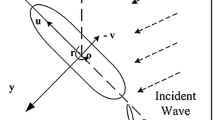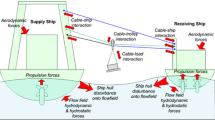Abstract
A calculation model to simulate nonsymmetric ship collisions, implying an arbitrary impact location and collision angle, is described in the paper. The model that is introduced is based on the time integration of twelve equations of motion, six for each ship. The motions of the ships are linked together by a mutual contact force. The contact force is evaluated as an integral over the surface tractions at the contact interface. The calculation model provides full time histories of the ship motions and the acting forces. Physical understanding of the underlying phenomena was obtained by a series of model-scale experiments in which a striking ship collided with an initially motionless struck ship. In this paper, numerical simulations of four nonsymmetric collisions are presented and the calculations are validated with the results of the experiments.













Similar content being viewed by others
References
Eliopoulou E, Papanikolaou A (2007) Casualty analysis of large tankers. J Mar Sci Technol 12:240–250
Tuovinen J (2005) Statistical analysis of ship collisions (master’s thesis). Helsinki University of Technology, Helsinki
Minorsky VU (1959) An analysis of ship collision with reference to protection of nuclear power plants. J Ship Res 3:1–4
Woisin G (1988) Instantaneous loss of energy with unsymmetrical ship collisions. Schiff Hafen 40:50–55
Pedersen PT, Zhang S (1998) On impact mechanics in ship collisions. J Mar Struct 11:429–449
Petersen MJ (1982) Dynamics of ship collisions. Ocean Eng 9:295–329
Brown AJ (2002) Collision scenarios and probabilistic collision damage. J Mar Struct 15:335–364
Cummins WE (1962) The impulse response function and ship motions. Schifftechnik 9:101–109
Ogilvie TF (1964) Recent programme towards the understanding and prediction of ship motions. In: Proceeding 5th Symp on Naval Hydrodynamics, Bergen, Norway, 10–12 Sept 1964, pp 3–128
Tabri K, Määttänen J, Ranta J (2008) Model-scale experiments of symmetric ship collisions. J Mar Sci Technol 13:71–84
Clayton BR, Bishop RED (1982) Mechanics of marine vehicles. E. F. N. Spon Ltd, London
Gale C, Eronen H, Hellevaara M, Skogman A (1994) Perceived advantages of Z-drive escort tugs. In: Proceeding Int Towage and Salvage Convention, Southampton, UK, 17–21 Oct 1994, pp 163–176
Matusiak J (2001) Importance of memory effect for ship capsizing prediction. In: Proceeding 5th Int Workshop on Ship Stability, Trieste, Italy, 12–13 Sept 2001
Dupont P, Armstrong B, Hayward V (2000) Elasto-plastic friction model: contact compliance and stiction. In: Proceedings of the American Control Conference. AACC, Chicago, pp 1072–1077
Canudas de Wit C, Olsson H, Åström J, Lischinsky P (1995) A new model for control of systems with friction. IEEE Trans Automat Contr 40:419–425
Dormand JR, Prince PJ (1980) A family of embedded Runge–Kutta formulae. J Comp Appl Math 6:19–26
Wevers LJ, Vredeveldt AW (1999) Full scale ship collision experiments (TNO report 98-CMC-R1725). TNO, Delft
Määttänen J (2005) Experiments on ship collisions in model scale (master’s thesis). Helsinki University of Technology, Helsinki
Journée JMJ (1992) Strip theory algorithms (report MEMT 24). Delft University of Technology, Delft
Ranta J, Tabri K (2007) Study on the properties of polyurethane foam for model-scale ship collision experiments (report M-297). Helsinki University of Technology, Helsinki
Tabri K, Broekhuijsen J, Matusiak J, Varsta P (2009) Analytical modelling of ship collision based on full-scale experiments. J Mar Struct 22:42–61
Author information
Authors and Affiliations
Corresponding author
Appendices
Appendix 1: Scalar form of equations of motion
For numerical integration, the equation of motion
is rearranged to obtain a more convenient form:
where the matrices have the following component form:
with
and
where m is the structural mass, a i and a ii are the translational and rotational added masses, A W is the waterplane area, x F is the longitudinal centre of flotation, ρ is the water density, g is the gravitational acceleration, GM T is the transverse metacentric height, and GM L is the longitudinal metacentric height. The subscript characters in the mass and inertia terms follow the common notation; a single character refers to a value involved with translational motions, and two characters refer to rotational motion or to a coupling between two motion components.
The restoring force is divided into a constant part \( \left. {{\mathbf{F}}_{\text{R}} } \right|_{{t_{j} }} \) evaluated at the beginning of the time increment at t = t j , and into the change \( \left. {{\text{d}}{\mathbf{F}}_{\text{R}} } \right|_{{t_{j + 1} }} \) in the force during the increment:
This split is necessary, as the restoring force depends on the ship’s position with respect to the inertial coordinate system given by the position vector R and Euler’s angles. The increase in the force during the time increment is still evaluated via the displacements in the local coordinate system, but because of small angular displacements the error will be negligible.
During the time increment, the matrices and vectors on the left-hand side of Eq. 39 are updated several times within the increment, while the right-hand side is kept constant.
Appendix 2: Test matrix for second and third sets
Test | β (deg) | Bulb | L C (m) | mA (kg) | mB (kg) | u0 (m/s) | F AC,x (N) | F AC,y (N) | ED,P (J) |
|---|---|---|---|---|---|---|---|---|---|
201 | 90 | 1 | 0.82 | 28.5 | 30.5 | 0.87 | 226 | 25 | 3.91 |
202 | 90 | 1 | 0.83 | 28.5 | 30.5 | 0.71 | 179 | 17 | 2.36 |
203 | 90 | 1 | 0.83 | 28.5 | 30.5 | 0.38 | 91 | 13 | 0.75 |
204 | 90 | 1 | 0.45 | 28.5 | 30.5 | 0.91 | 300 | 36 | 6.30 |
205 | 90 | 1 | 0.48 | 28.5 | 30.5 | 0.38 | 115 | 6 | 0.95 |
206 | 90 | 1 | 0.38 | 28.5 | 30.5 | 0.71 | 221 | 13 | 3.43 |
207 | 90 | 1 | 0.80 | 28.5 | 20.5 | 0.90 | 200 | 27 | 4.2 |
208 | 90 | 1 | 0.41 | 28.5 | 20.5 | 0.89 | 229 | 33 | 4.92 |
301 | 120 | 1 | 0.37 | 28.5 | 20.5 | 0.87 | 172 | 47 | 4.20 |
302 | 120 | 1 | 0.32 | 28.5 | 20.5 | 0.30 | 59 | 14 | 0.51 |
303 | 120 | 1 | 0.3 | 28.5 | 44.5 | 0.84 | 204 | 52 | 6.50 |
304 | 120 | 1 | 0.38 | 28.5 | 44.5 | 0.37 | 89 | 21 | 1.01 |
305 (sliding) | 145 | 1 | 0.32 | 28.5 | 20.5 | 0.34 | 44 | 29 | 0.54 |
306 (sliding) | 145 | 1 | 0.44 | 28.5 | 20.5 | 0.87 | 115 | 65 | 3.91 |
307 (sliding) | 145 | 1 | 0.38 | 28.5 | 44.5 | 0.84 | 118 | 67 | 5.47 |
308 | 145 | 1 | 0.34 | 28.5 | 44.5 | 0.28 | 45 | 27 | 0.52 |
309 (sliding) | 145 | 3 | 0.46 | 28.5 | 20.5 | 0.87 | 120 | 86 | 3.19 |
310 (sliding) | 145 | 2 | 0.44 | 28.5 | 20.5 | 0.88 | 142 | 94 | 3.19 |
311 | 120 | 3 | 0.42 | 28.5 | 20.5 | 0.88 | 217 | 69 | 4.25 |
312 | 120 | 2 | 0.41 | 28.5 | 20.5 | 0.86 | 313 | 104 | 4.64 |
313 | 60 | 1 | 0.29 | 28.5 | 20.5 | 0.76 | 177 | 41 | 3.14 |
314 | 60 | 1 | 0.32 | 28.5 | 20.5 | 0.36 | 80 | 16 | 0.81 |
315 | 60 | 1 | 0.38 | 28.5 | 44.5 | 0.75 | 202 | 52 | 4.35 |
316 | 60 | 1 | 0.4 | 28.5 | 44.5 | 0.43 | 104 | 24 | 1.17 |
About this article
Cite this article
Tabri, K., Varsta, P. & Matusiak, J. Numerical and experimental motion simulations of nonsymmetric ship collisions. J Mar Sci Technol 15, 87–101 (2010). https://doi.org/10.1007/s00773-009-0073-2
Received:
Accepted:
Published:
Issue Date:
DOI: https://doi.org/10.1007/s00773-009-0073-2




